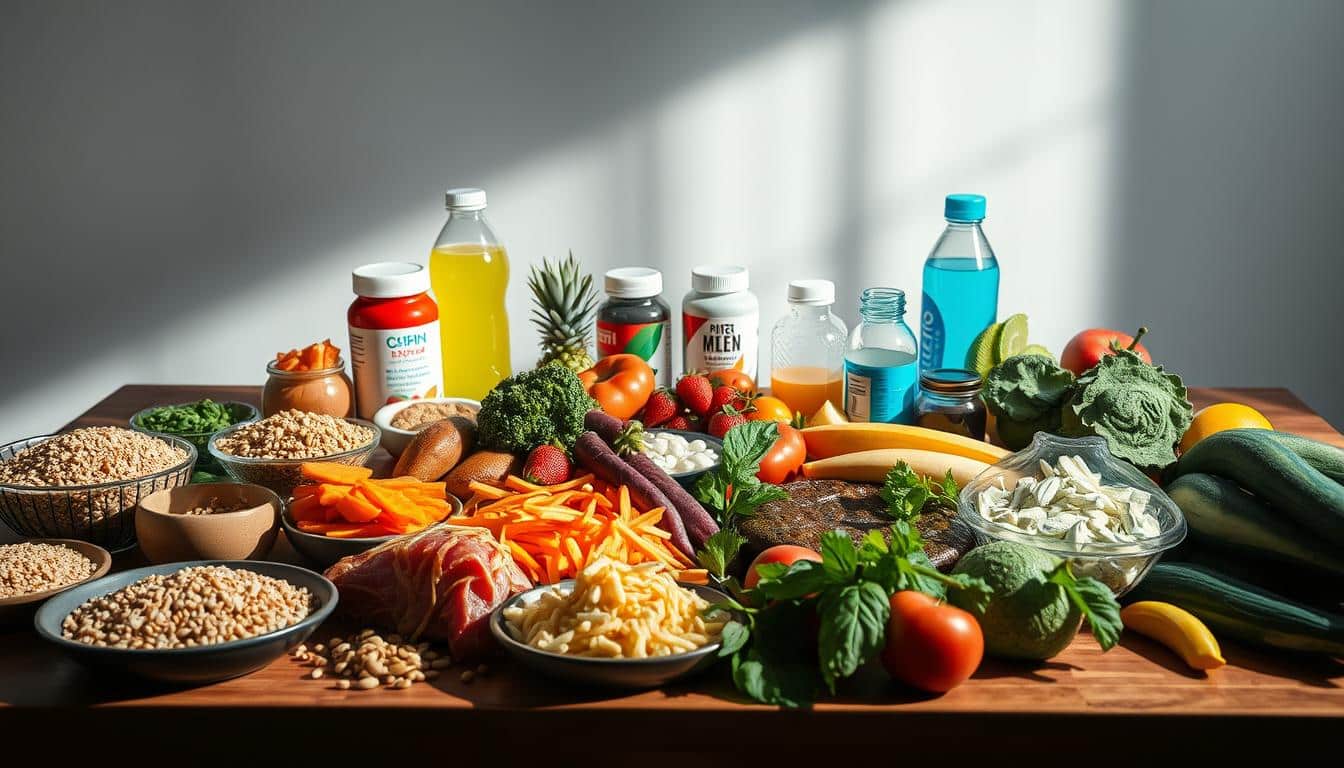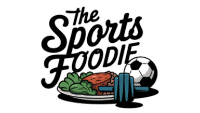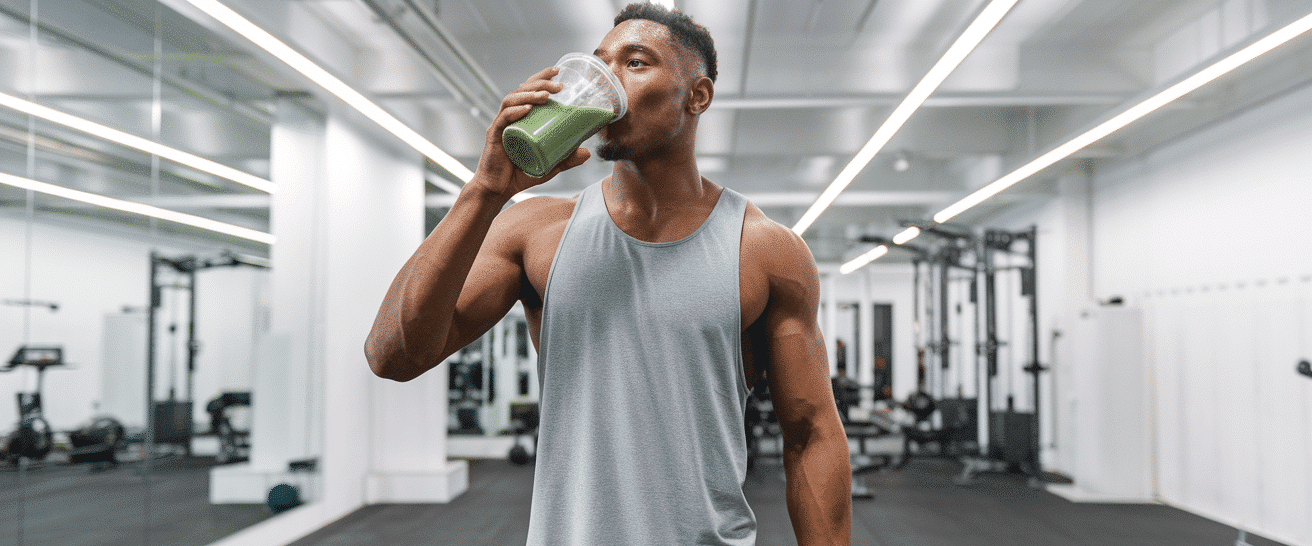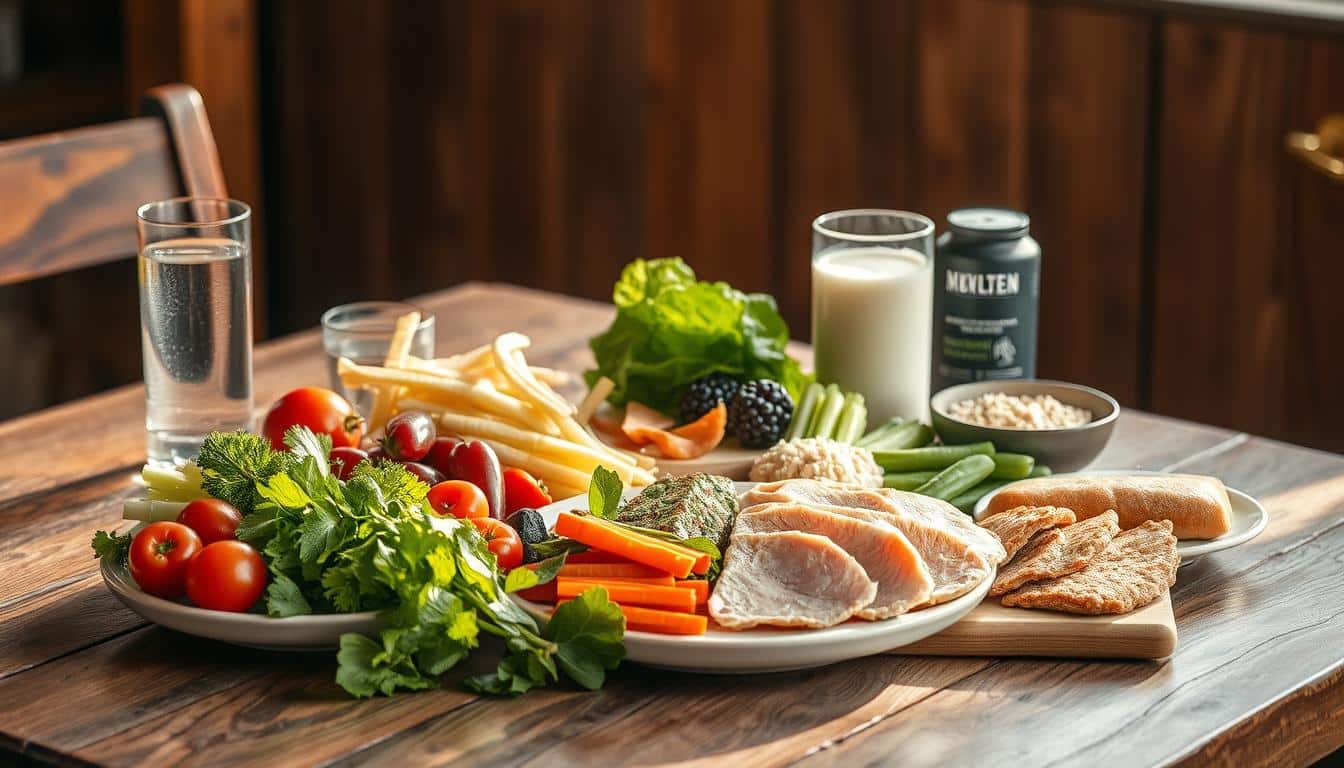Did you know some active adults do well near 2,300 kcal with a 50% carbs, 25% fat, 25% protein split? That split gives a clear starting point, but your size, sex, and training load will change the math.
I wrote this guide so you get a simple path to lose fat and keep sessions strong. You’ll find quick pre-workout options, easy post-session recovery ideas, and ways to match calories to hard or light days.
Hydration matters. REDs — relative energy deficiency in sport — can harm health and training when intake is too low. I keep rules short and practical so you can build a day that fits your training and schedule.
Expect plate builds, snack swaps, and a seven-day structure you can rotate. By the end, you’ll have one action list to start today and simple checks to track progress in a few weeks.
What athletes need from a weight loss meal plan
Your target is simple — reduce body fat while performance stays steady. You want to feel strong in every session and recover overnight. That guides what you eat each day.
Define the goal
Keep performance intact while losing fat. Set a small calorie deficit that preserves energy. Protein must stay high to protect muscle and repair tissue.

Match intake to training
Match calories to the session. Hard days get more carbs and energy. Light days are lower. This avoids REDs — low intake that raises fatigue and injury risk.
- Fuel sessions and recovery with carbs, protein, and healthy fats.
- Pick foods you digest well before hard efforts.
- Watch hydration and colorful foods for vitamins and immune support.
- Keep the plan simple so you repeat it on busy days.
| Day Type | Focus | Quick target |
|---|---|---|
| Hard | Higher carbs, energy, hydration | More carbs, normal protein |
| Light | Moderate carbs, maintain protein | Lower carbs, steady protein |
| Rest | Lower energy, recovery, micronutrients | Lower carbs, protein to repair |
How to set calories and macros for weight loss and performance
Start with your current calories and nudge them down slightly so training stays strong and energy holds steady. Use your maintenance intake as the anchor, then pick a small deficit of 250–500 kcal per day depending on how intense your training is.
Set a small calorie deficit based on current training
Step 1: Find maintenance from recent weeks of steady training. Subtract 250–500 kcal to create a gentle deficit.
If sessions feel weak, raise intake by 150–250 kcal and retest for two to three days.
Use macro ranges from sports nutrition research
- Target a protein floor near 0.7–1.0 g per lb bodyweight to protect muscle.
- When unsure, use a 50% carbohydrates / 25% fat / 25% protein split (example: 2,300 kcal at 50/25/25).
- Fine-tune after one week of feedback on energy and recovery.

Adjust carbs on heavy and light training days
Raise carbs around hard sessions and pull some back on easy days. Example plates: chicken with rice and vegetables plus a glass of milk on a hard day.
Easy days can include more salad, cheese in moderation, and lean protein with fewer starches. Use a meal plan based approach at the start, then tweak portions after tracking a few days.
| Day Type | Calories | Macro focus |
|---|---|---|
| Hard | Maintenance or +0–150 kcal | Higher carbohydrates, normal protein |
| Easy | Deficit 250–500 kcal | Lower carbohydrates, steady protein |
| Adjust | +150–250 kcal if performance drops | Raise carbs or overall kcal briefly |
Pre-workout fuel that supports training while cutting
A quick, predictable pre-workout bite keeps energy high without upsetting your stomach. Pick options by how much time you have before the session.
Choose simple carbohydrates when time to digest is short
If you have under 30 minutes, stick to simple carbohydrates. Good choices: toast, an English muffin, a granola bar, pretzels, or a sports drink. These digest fast and reduce cramps.
Add moderate protein and fat when you have more time
With 60–120 minutes, add a little protein and fat. Try peanut butter on bread or banana peanut butter on toast. These combos give steady energy and satiety without slowing you down.
Time your snack based on session intensity and duration
- 3–4 hours out: a small meal, then a top-up snack 30 minutes before if needed.
- High-intensity: always eat carbs before you start to protect output.
- Easy short sessions: you may skip a snack if your last meal was recent.
- Test low-fiber options if your stomach is sensitive and keep grab-and-go choices ready the night before.
- Sip water in the 60 minutes before training; add electrolytes when you sweat heavily.
Post-workout recovery meals that protect muscle
The window after exercise is your best time to kick-start recovery and protect hard-earned muscle. Eat protein within one to two hours to start repair and keep lean mass. Pair that protein with carbohydrates to refill muscle glycogen.
Aim for about 25–40 grams of protein in your post-session food, depending on body size and how tough the session was. Good combos: chicken breast with rice and roasted carrots, Greek yogurt with fruit and a glass of milk, or eggs with toast and a small side salad.
If time is tight, a protein shake plus a banana peanut snack works well late at night. Keep fat moderate so digestion stays quick. If you can’t stomach a full plate, start with the shake and follow with a small bowl of rice and chicken when hunger returns.
- Use reliable bases: Greek yogurt, cottage cheese, eggs, or chicken.
- Add a simple veg like carrots for vitamins.
- Raise carbohydrates in the next post-session food if soreness lingers.
| Quick option | Protein (g) | Why it works |
|---|---|---|
| Chicken breast + rice + carrots | 30–40 | Protein repair + carbs to refill glycogen |
| Greek yogurt + fruit + milk | 25–30 | Fast digestion and calcium; easy to scale |
| Shake + banana peanut | 20–35 | Speedy when time is short; follow with a bowl if needed |
Hydration and electrolytes for training and events
Hydration is one of the simplest performance tools you can use daily. Start each day with a glass of water and keep a bottle in sight. That small habit removes guesswork and boosts intake across the day.
Use pale-yellow urine as a quick check during blocks of training. It’s simple, reliable, and predictable.
During long or hot sessions, add sodium or a balanced electrolyte mix to replace sweat losses and aid fluid absorption. Sip small amounts often to reduce gut stress; increase frequency when heat rises.
- Weigh before and after long practices to estimate sweat loss.
- Rehydrate by drinking 16–24 ounces per pound lost.
- Include water-rich food like fruit and yogurt in meals to support total intake.
- Plan a bottle strategy by time and distance, and test it in practice before events.
- Reduce high-fiber or carbonated drinks just before start time if your stomach is sensitive.
- Keep a backup electrolyte packet in your bag in case event stations run out.
- Log any cramp episodes with weather and intake notes to refine your approach next time.
| Check | Action | Why it matters |
|---|---|---|
| Morning bottle | Drink 12–16 oz on wake | Starts hydration and aids morning recovery |
| Weigh-in | Measure pre/post long session | Accurate guide to fluid needs |
| Electrolytes | Add during >60–90 min or heat | Replaces sodium lost in sweat and helps absorption |
If you want a deeper look at how nutrition ties to performance, read this guide on how nutrition affects performance. It pairs well with the tips above and helps you plan intake by time and training needs.
Seven-day structure ideas from proven athlete meal plans
Build a weekly rhythm around session times and you’ll remove guesswork from day eating. Below are simple, repeatable options you can rotate with small swaps.
Examples for morning, afternoon, and evening sessions
- Morning sessions: Go light pre-workout with cereal or toast. After training, eat eggs with oats or PB banana peanut butter toast and a splash of milk if it sits well.
- Early afternoon: Build a bowl with chicken, rice, peas, and tomatoes. Save chicken breast dinners with broccoli for recovery nights.
- Night sessions: Have an earlier dinner like salmon with sweet potatoes and carrots, take a small pre-snack (half a banana + graham cracker), then finish with a shake.
Quick breakfast, lunch and snack ideas
Overnight oats with granola, eggs and bread with tomatoes, or yogurt with fruit and peanut butter work well. Lunches can be a chicken pita with cheese, a chickpea wrap with carrots, or a rice bowl with turkey or beans.
| Time | Example | Why it fits |
|---|---|---|
| Morning | Rice Chex or toast + PB | Light pre-workout carbs, easy digestion |
| Afternoon | Chicken pita, rice bowl | Protein + carbs to fuel late sessions |
| Evening | Chicken breast + quinoa, broccoli | Lean protein, recovery-focused dinner |
If you want extra breakfast ideas, see this guide to high-energy breakfast foods to jump-start your day.
Foods to choose and foods to limit near hard efforts
Pick foods that give steady energy before hard sessions and avoid items that trigger stomach trouble. Keep choices simple and tested in practice so race day is predictable.
High-carb options to use close to start
- Rice, white pasta, plain bread, and potatoes — low-fiber starches that digest fast.
- Bananas, applesauce pouches, and low-fiber cereal — quick simple carbohydrates when time is short.
- Low-fiber fruit or bars 30–60 minutes before a session if you need a late top-up.
Lean proteins and building blocks
- Chicken breast, turkey, fish, eggs, or beans — pick what your stomach tolerates on practice days.
- Pair small amounts of protein with carbs when you have 60–120 minutes before start.
What to limit before events
- Avoid high fat meals; fat slows digestion and can leave you sluggish.
- Skip high-fiber food like broccoli or large bean portions close to the start to reduce cramping.
- If milk or high-lactose dairy upsets you, use lactose-free options and skip heavy cream sauce or rich tomato sauce pre-race.
- Reserve carb-loading (more rice, pasta, potatoes) for the day before long events, not the day of short efforts.
| Goal | Choose | Avoid |
|---|---|---|
| Quick pre-start fuel | Applesauce, small bar, banana | Fried food, heavy sauce |
| 1–2 hours pre | Chicken + rice, eggs + toast | Large beans dish, full-fat dairy |
| Day-before topping | Pasta, potatoes, bread | Spicy or greasy food |
Test everything in practice. Write down what works and repeat it on the big day.
weight loss meal plan for athletes: step-by-step build
Start by turning your weekly training schedule into a simple eating map you can follow each day. This gives structure and removes guesswork on busy training weeks.
Step one: set a calorie target and protein floor
Pick maintenance minus 250–500 kcal as your starting target. Make sure protein sits near 0.7–1.0 g per pound to protect muscle.
Step two: map training times and insert pre/post meals
Put hard sessions on your calendar and slot pre-workout simple carbs when time is short. Use moderate protein and fat when you have 60–120 minutes before start.
Step three: fill plates with carbs, protein, vegetables
Build each plate with a palm of protein, a fist or two of carbohydrates, and two handfuls of vegetables on easy days. Include chicken options as a go-to protein choice.
Step four: plan snacks for long gaps and late sessions
Pack portable snacks: yogurt, fruit, peanut butter with crackers, or chicken wraps. If you need eat before a late session, keep it light and finish with a shake after.
Step five: review energy, hunger, and performance, then adjust
At the end of each day eating, check energy and session output. If you feel low, add one fist of carbs the next day. Track intake for 7–10 days and repeat what works.
- Use a meal plan based template for one week, then tweak for travel or schedule shifts.
- Keep two fast meals ready: chicken and rice, or eggs and toast.
- Drop foods that cause GI issues or low training energy; repeat the reliable meals.
Adjustments by sport, age, and competition schedule
Different sports and schedules call for small, targeted tweaks to your nutrition and timing. Match what you eat to growth, event length, or weigh-in windows. Keep it simple and test it in practice.
Youth and college needs
Young athletes grow fast and train often. They usually need more frequent eating to support growth and recovery.
Tip: schedule small, regular meals and snacks between classes and training so the diet meets energy demand and reduces injury risk.
Endurance and long events
For long races, add extra carbohydrates 24–48 hours before to top up glycogen. Choose rice, simple carbohydrates, and familiar foods you tolerate.
Weigh-ins and strength sports
If a weigh-in compresses your pre-start window, keep early hydration and a small plate after weigh-in. Pick low-fiber, easy-to-digest foods.
- Youth and college schedules benefit from frequent meals to cover growth and training demands.
- Endurance athletes add carbohydrates 24–48 hours pre-race to raise glycogen stores.
- If weigh-ins are close to start, have a small meal then rely on simple carbohydrates and fluids 30–60 minutes before.
- Test light, low-fiber options after weigh-in: eggs, toast, fruit, and fluids digest well for most.
- Build plates you tolerate: chicken breast with rice and broccoli, or turkey with sweet potatoes and tomatoes.
- Pack portable chicken, turkey, or eggs during travel so your diet stays consistent.
- Work with a nutritionist when schedules or weigh-ins get tight. Log what works and update your approach after each meet.
| Situation | Quick food choice | Why it works |
|---|---|---|
| Growth & training | Chicken, eggs, fruit | Frequent protein and carbs support recovery |
| 48h pre-endurance | Rice and simple carbohydrates | Maximizes glycogen |
| Post weigh-in | Toast, eggs, fluids | Fast digestion and rehydration |
Flexible meal plans and tracking for long-term success
Use simple patterns that teach you what your body needs over time. Start with a few example meal plans as a base. Copy them, tweak portions, and test what fits your training and schedule.
Treat templates as guides — not laws. That gives you space to swap foods, travel, or handle a busy shift without derailing progress.
Track briefly, learn quickly
Track intake for one to two weeks to learn average calories, macros, and hunger cues. Tracking teaches portion sense and highlights patterns in energy, sleep, and soreness.
- Rotate two to three plan templates: workday, rest day, heavy training day.
- Keep a plan based grocery list to speed shopping and reduce waste.
- Save three fallback meals for travel and late nights.
- See a nutritionist if progress stalls or schedules get complex.
| Action | Why it helps | How often |
|---|---|---|
| Short tracking block | Shows real intake and hunger trends | 1–2 weeks |
| Rotate templates | Makes choices automatic and flexible | Weekly |
| Review notes | Adjust portions based on energy and soreness | Every 2 weeks |
Conclusion
Close the loop: map your sessions, set a small deficit, and place protein and carbohydrates around workouts to protect performance.
Make sure you have two fast post options ready—try a shake and a chicken bowl—or a quick chicken and rice bowl after late nights. Keep peanut butter, fruit, yogurt, and simple breads on hand as reliable pre-session fuel.
Use a plan based weekly template, track intake for a short window, then repeat what works. Keep hydration front and center on hot days and during long sessions to protect output and performance.
Review notes weekly. Make sure you raise intake if fatigue or soreness grows. Start today, test one change each week, and lock in the foods and routines that help you feel and perform best.


